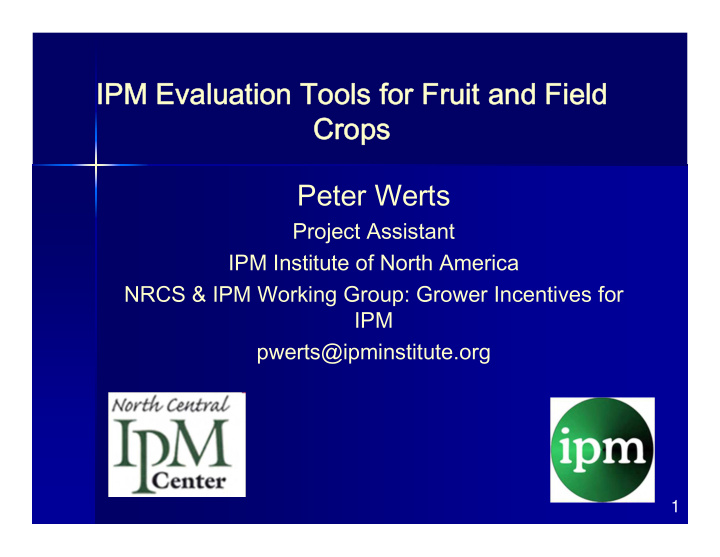



IPM Evaluation Tools for Fruit and Field Crops Peter Werts Project Assistant IPM Institute of North America NRCS & IPM Working Group: Grower Incentives for IPM pwerts@ipminstitute.org 1
IPM Reduces Pesticide Risk and Exposure IPM is a systems-based approach: – Reduces environmental, health and economic risks. – Implemented as an ongoing series of science-based, pest management evaluations, decisions and interventions. Conventional pesticide sales down 3% per year between 1999 and 2006. (Crop Life, 2007) Bald eagle nesting pairs increase Long road ahead… from 417 to 5,748 after DDT ban. - Fish & Wildlife Service, 2003 94% of fish, 94% of surface water and 33% of ground water samples collected from 1992 and 2001 showed contamination with one or more pesticides. (2006 U.S. Geological Survey) 2
Presentation Overview NRCS & IPM working group IPM Tool background Use in 595 Practice Standard IPM Tool demo Additional Resources Questions? 3
North Central Working Group: Grower Incentives for IPM http://www.nrcs.ipm.msu.edu/ Funded by North Central IPM Center since 2006; additional support from Northeastern IPM Center for IPM CAPs work in 2009-2010. 128 members from within and outside of region. Goal: Increase grower awareness and participation in NRCS programs including EQIP for IPM. Outputs include: Field crop, vegetable and fruit IPM guidelines; Compiled EQIP financial assistance contract numbers; http://www.nrcs.ipm.msu.edu/nrcs/state_resources Mini-grants and outreach to engage NRCS and create new 595 options in: IN, OH, IA, KS and MN; Networking, resource sharing other working groups and national NRCS staff. 4
IPM Tool Background NE Vegetable IPM Tool developed 2008 – Kathy Murray, Maine Department of Ag. – Alice Begin and Autumn Birt, NRCS. Adapted to North Central Region, 2009. – Fruit and field crops. – Funded by North Central IPM Center. Current revisions in-progress to adapt vegetable tool for North Central Region. 5
Why IPM Tools? Help IPM planning become: – Site specific; – Crop specific. Catalogue of IPM practices Compliment production guides 6
How do they help NRCS? Identify IPM Strategies for 595 Practice Standard: – PAMS (Prevention, Avoidance, Monitoring, Suppression). Qualify producers for cost-share and technical assistance programs. Assess and identify IPM and other conservation practices. Identify practices with low adoption. Template for local IPM Elements and Guidelines. 7
IPM Planning for NRCS The foundation of all NRCS pest management planning is based on utilizing environmentally sensitive prevention , avoidance , monitoring and suppression (PAMS) strategies to manage weeds, insects, diseases, animals and other organisms that directly or indirectly cause damage or annoyance to agricultural crops. 8
North Central IPM Tools Format MS Word: – Fruit and field crops. MS Excel with macros: – Fruit crop only. Contents: – Guide Sheet; – PAMS strategies; – Resource list. 9
10 Field and Fruit Crop Tool: MS Word
11 Fruit Crop Tool: MS Excel Click Here
Accessing the IPM Tools Available for down from NRCS & IPM Working Group website: http://www.nrcs.ipm.msu.edu/ 12
Additional Resources Guide to IPM Elements and Guide lines – Tom Green, IPM Institute of North America and Curt Petzoldt, Cornell University, 2009. http://www.ipm.msu.edu/work- group/pdf/IPMElementsGuidelines09.pdf Ohio IPM Elements and Guidelines – http://www.ipm.osu.edu/default.asp 13
Thank You…Questions? Thanks to: North Central and North East IPM Centers NRCS & IPM Working Group: Grower Incentives for IPM The following working group members provided comments on the tools: Bill Kuenstler, Dave Epstein, Bryan Jensen, Tom Green, Kathy Murray. Additional comments: Patty McManus, UW Madison Plant pathology. 14
Recommend
More recommend